Build flows with HTML Tables, CSVs and other new features like OCR and image content detection
New actions to build tables and lists
Steps in a flow can output a list of items, and up until today, the only way that you could handle such lists was with an Apply to each. For example, if you get a list of attachments for an Email, you can upload each of them to your OneDrive for Business (as shown in this template). However, sometimes you want to get a list of items and include these items in a single action, such as sending an email with the items, or saving them all to a file. Today, this is possible with the new Create HTML Table, Create CSV Table and Join actions.
Create HTML Table
The first new action, Create HTML Table is particularly useful when you want to send emails that contain a full list of all of the items from a previous step. One simple example is Wunderlist tasks: they can have several Subtasks associated with them. With the new action, you can now get a table in your email with the list of all those subtasks. Just add an action called Get Subtasks, and then pass the contents of that step to the Create HTML Table action:
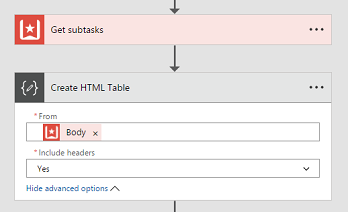
There is advanced option to Include headers – this will tell you what each column is. Once the email is sent, it will look something like this:
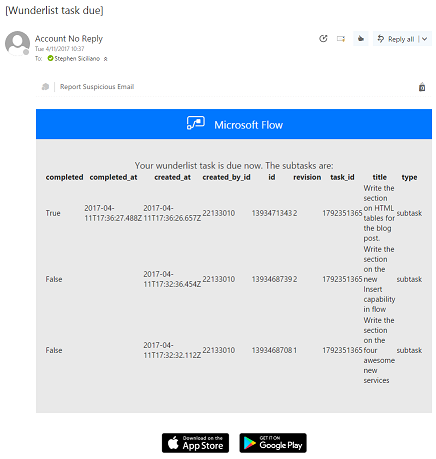
Check out the template here to try this yourself.
Create CSV Table
The second new action is Create CSV Table. This action is most useful when you want to save the contents to a file. These new actions that interact with lists now make it much easier to run flows on a schedule. For example, you can have a flow that will run once a week, and save all of the items in a SharePoint list to a CSV file for archiving.
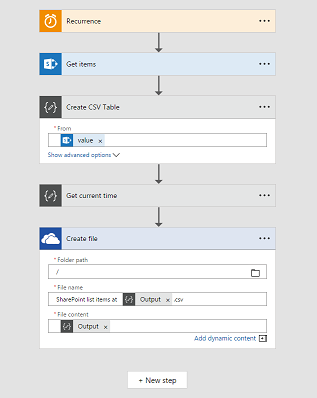
This action works just like the HTML action, but instead outputs a CSV table, which you can then open in any spreadsheet program, such as Excel. Try out this template to see this example of how it works.
Join action
The third new action, Join, is also very simple. It works with any list of strings. For example, the Twitter action outputs a list of Media URLs. You can Join each of these urls together with an HTML tag like <br> and then you get a simple list that looks like this:
<br>http://example.com/image1.jpg <br>http://example.com/image2.jpg
Insert steps anywhere in your workflow
Previously, you had to add every step to the bottom of the workflow and then drag-and-drop it to where you want. We have added new "+" buttons anywhere you can add an action, so now it's easy to insert a step right in the middle of a large workflow.
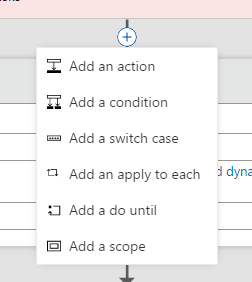
This will make it easier than ever to edit and enrich your existing flows.
New services
This week there were three new services from our partners:
- 10 to 8 Scheduling – 10 to 8 Scheduling is a powerful appointment management, communications & online booking system.
- Act! – Act! helps individuals, small businesses, and sales teams organize prospect and customer details in one place.
- Inoreader – Inoreader is a content reader built for power users. Use Inoreader to subscribe to feeds, read articles or catalogue them for viewing later.
Computer Vision API
Finally, we have also added support for the Computer Vision API. The Computer Vision API lets you create flows that extract rich information from images to categorize and process visual data.
To get started, you will first have to get an API get from Cognitive Services. Click this link, and be sure to select Computer Vision. You may need to verify your email. You can then copy the Key for this API to your clipboard (you can use Key 1 or Key 2):

Next, create a flow and select one of the actions. When you do, you will be asked to name the connection and pasted in the Key you copied:
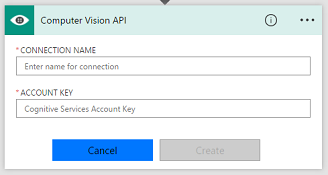
This API has many useful functions including:
- Describe Image – generates a description of an image in human readable language with complete sentences
- Tag Image – generates a list of words, or tags, that are relevant to the content of the supplied image
- Generate Thumbnail – get a thumbnail image with the user-specified width and height
- Optical Character Recognition (OCR) – detects text in an image and extracts the recognized characters into text you can use in other steps
We would love to hear what types of scenarios you can build with this great new API on Twitter or on our Community Forum.



